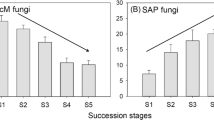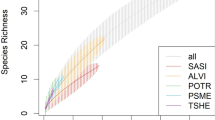Abstract
Saprophytic fungi are one of the most active decomposers of forest litter, and their diversity may be influenced by the spatial heterogeneity of substrates. We examined the changes in saprophytic community structure and composition across a volcanic soil chronosequence, at Sierra del Chichinautzin, Mexico. Saprophytic fungi were collected for three consecutive years at three sampling sites with contrasting soil properties in a volcanic soil chronosequence ranging from 1,835 years B.P. to 10,000 years B.P. Although no significant differences were found in terms of abundance and richness between the three sites, Shannon diversity was higher at the youngest, less-fertile site. The high percentage of site-exclusive species showed that species composition was strongly dependent on the site and therefore on soil parameters. Different saprophytic species had divergent responses to soil variables, but most fungal taxa correlated negatively with the edaphic factors we measured. The highest diversity found at the young, less fertile site may represent an “insurance” mechanism against harsh conditions, since different species are likely to play various ecological functions which may lead to a more efficient degradation of recalcitrant substrates.




Similar content being viewed by others
References
Andrén O, Clarholm M, Bengtsson J (1995) Biodiversity and species redundancy among litter decomposers. In: Collins HP, Robertson GP, Klug MJ (eds) The Significance and Regulation of Soil Biodiversity. Kluwer, Dordrecht, pp 141–151
Aplet GH, Hughes RF, Vitousek PM (1997) Ecosystem development on Hawaiian lava flows: biomass and species composition. J Veg Sci 9:17–26
Boddy L, Hynes J, Bebber DP, Fricker MD (2009) Saprotrophic cord systems: dispersal mechanisms in space and time. Mycoscience 50:9–19
Bon M (2004) Champignons de France et d´Europe occidentale. Flammarion, France
Bray RH, Kurtz LT (1945) Determination of total, organic, and available forms of phosphorus in soils. Soil Sci 59:39–45
Cairney JWG (2005) Basidiomycete mycelia in forest soils: dimensions, dynamics and roles in nutrient distribution. Mycol Res 109:7–20
Deacon JW (1985) Decomposition of filter paper cellulose by thermophilic fungi acting singly, in combination, and in sequence. Trans Br Mycol Soc 85:663–669
Deacon LJ, Pryce-Miller EJ, Frankland JC, Bainbridge BW, Moore PD, Robinson CH (2006) Diversity and function of decomposer fungi from a grassland soil. Soil Biol Bioch 38:7–20
Dighton J (1983) Phosphatase production by mycorrhizal fungi. Plant Soil 71:455–462
Dighton J (2003) Fungi in Ecosystem Processes. Marcel Dekker, New York
Dix NJ, Webster J (1995) Fungal ecology. Chapman & Hall, London
Donnelly DP, Boddy L (1998) Developmental and morphological responses of mycelial systems of Stropharia caerulea and Phanerochaete velutina to soil nutrient enrichment. New Phytol 138:519–531
Gebauer G, Taylor AFS (1999) 15 N natural abundance in fruit bodies of different functional groups of fungi in relation to substrate utilization. New Phytol 142:93–101
Harold S, Tordoff GM, Jones TH, Boddy L (2005) Mycelial responses of Hypholoma fasciculare to collembola grazing: effect of inoculum age, nutrient status and resource quality. Mycol Res 109(8):927–935
Hedger J (1985) Tropical agarics, resource relations and fruiting periodicity. In: Moore D, Casselton LA, Wood DA, Frankland JC (eds) Developmental Biology of Higher Plants. Cambridge University Press, Cambridge, pp 41–86
Ihaka R, Gentleman R (1996) R: a language for data analysis and graphics. J Comput Graph Stat 5:299–314
Kuyper TW, Verschoor BC (1995) Enhancement of nitrification rates in vitro by interacting species of saprotrophic fungi. Mycol Res 99:1128–1130
Laessøe T, Ryvarden L, Watling R, Whalley AJS (1996) Saprotrophic fungi of the Guinea - Congo Region. Proc R Soc Edinburgh 104B:335–347
Lodge DJ (1997) Factors related to diversity of decomposer fungi in tropical forests. Biodivers Conserv 6:681–688
Lodge DJ, Cantrell S (1995) Fungal communities in wet tropical forests: variation in time and space. Can J Bot 73:S1391–S1398
Márquez A, Verma SP, Anguita F, Oyarzun R, Brandle JL (1999) Tectonics and volcanism of Sierra Chichinautzin: extension at the front of the Central Trans—Mexican Volcanic belt. J Volcanol Geotherm Res 93:125–150
Mihál I, Bučinová K (2005) Species diversity, abundance and dominance of macromycetes in beech forest stands. J For Sc 51(5):187–194
Naeem S (1998) Species redundancy and ecosystem reliability. Conserv Biol 12:39–45
Ohlson M, Söderström L, Hörnberg G, Zackrisson O, Hermansson J (1997) Habitat qualities versus long-term continuity as determinants of biodiversity in boreal old-growth swamp forests. Biol Conserv 81:221–231
Peña-Ramírez VM, Vázquez-Selem L, Siebe C (2009) Soil organic carbon stocks and forest productivity in volcanic ash soils of different age (1835–30, 500 years B.P.) in Mexico. Geoderma 149:224–234
Petersen RH, Cifuentes J (1994) Notes on mating systems of Auriscalpium vulgare and A. villipes. Mycol Res 98:1427–1430
Richard F, Moreau PA, Selosse MA, Gardes M (2004) Diversity and fruiting patterns of ectomycorrhizal and saprobic fungi in an old-growth Mediterranean forest dominanted by Quercus ilex L. Can J Bot 82:1711–1729
Robinson CH, Dighton J, Frankland JC, Coward PA (1993) Nutrient and carbon dioxide release by interacting species of straw-decomposing fungi. Plant Soil 151:139–142
Rubino DL, McCarthy BC (2003) Composition and ecology of macrofungal and myxomycete communities on oak woody debris in a mixed-oak forest of Ohio. Can J For Res 33:2151–2163
Schimel JP, Gulledge JM, Clein-Curley JS, Lindstrom JE, Braddock JF (1999) Moisture effects on microbial activity and community structure in decomposing birch litter in the Alaskan taiga. Soil Biol Biochem 31:831–838
Senn-Irlet B, Bieri G (1999) Sporocarp succession of soil-inhabiting macrofungi in an autochtonous subalpine Norway spruce forest of Switzerland. For Ecol Manag 124:169–175
Setälä H, McLean MA (2004) Decomposition rate of organic substrates in relation to the species diversity of soil saprophytic fungi. Oecologia 139:98–107
Siebe C, Rodríguez-Lara V, Schaaf P, Abrams M (2004) Radiocarbon ages of Holocene Pelado, Guespalapa, and Chichinautzin scoria cones, south of Mexico City: Implications for archaeology and future hazards. Bull Volcanol 66:203–225
Smith SE, Read DJ (2008) Mycorrhizal symbiosis, 3rd edn. Academic, London
Steffen KT, Hofrichter M, Hatakka A (2000) Mineralisation of 14C-labelled synthetic lignin and ligninolytic enzyme activities of litter-decomposing basidiomycetous fungi. Appl Microbiol Biotechnol 54:819–825
Sulkava P, Huhta V (1998) Habitat patchiness affects decomposition and faunal diversity: a microcosm experiment on forest floor. Oecologia 116:390–396
van der Heijden MGA, Klironomos JN, Ursic M, Moutoglis P, Streitwolf-Engel R, Boller T, Wiemken A, Sanders IR (1998) Mycorrhizal fungal diversity determines plant biodiversity, ecosystem variability and productivity. Nature 396:69–72
Velázquez A (1994) Multivariate analysis of the vegetation of the volcanoes Tláloc and Pelado, Mexico. J Veg Sci 5:263–270
World Reference Base (WRB) 2006 World Reference Base for Soil Resources, second edn. World Soil Resources Reports No. 103. FAO, Rome
Zakaria AJ, Boddy L (2002) Mycelial foraging by Resinicium bicolor: interactive effects of resource quantity, quality and soil composition. FEMS Microbiol Ecol 40:135–142
Acknowledgements
This work was supported by a grant from the Programa de Apoyo a Proyectos de Investigación e Innovación Tecnológica (PAPIIT) of the Universidad Nacional Autónoma de México (Project numbers IN 225703, 230507 and 119609). We thank the representatives of Topilejo and Cuajomulco communities for authorizing the field work and all the persons that helped with the sporocarp sampling during three years. Víctor Peña-Ramírez and Christina Siebe provided the soil results and Kumiko Shimada helped with the soil characterization.
Author information
Authors and Affiliations
Corresponding author
Rights and permissions
About this article
Cite this article
Reverchon, F., María del Ortega-Larrocea, P. & Pérez-Moreno, J. Saprophytic fungal communities change in diversity and species composition across a volcanic soil chronosequence at Sierra del Chichinautzin, Mexico. Ann Microbiol 60, 217–226 (2010). https://doi.org/10.1007/s13213-010-0030-7
Received:
Accepted:
Published:
Issue Date:
DOI: https://doi.org/10.1007/s13213-010-0030-7




